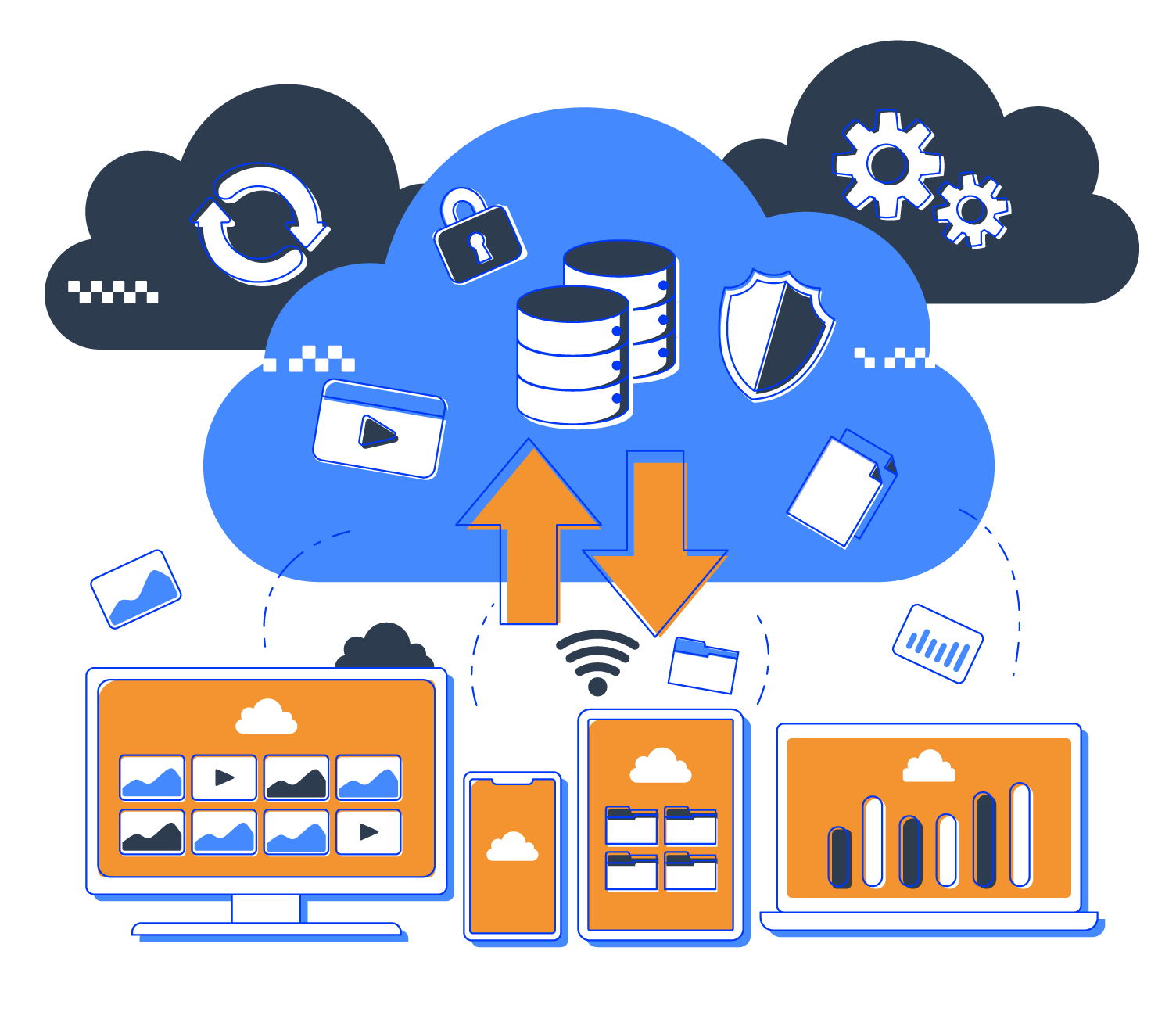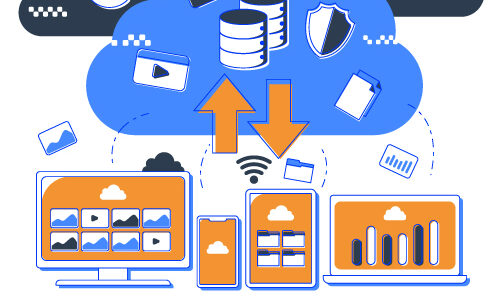Private Cloud as a Service
It can be confusing to keep track of the differences between all of the various types of clouds: Public Cloud, Private Cloud, Hybrid Cloud and Community Cloud. Which one is right for you and your company? In this article, we’ll look at private clouds and their benefits.
A private cloud delivers business functions as services. Private clouds are accessible and usable only by specific individuals within an organization and the private environments they create are supported by virtualized computing resources.
These are two concepts that address different issues and operate at different levels within the realm of enterprise IT. Private clouds do not share resources with other users. This type of cloud computing must not be confused with Amazon, DropBox. Microsoft or Google Docs which are all public cloud platforms that share resources with hundreds or thousands of other users.
Contact Us Now for a Free Security Audit
Why Choose a Private Cloud?
An essential part of a private cloud is virtualization that offers opportunities for reducing infrastructure costs, increasing operational efficiency, and improving deployment flexibility.
This virtualization creates a virtual machine (VM), a simulated virtual computer that behaves as if it were a computer with its own physical hardware. A server instance deployed with a VM offers many advantages over a physical machine including easy maintenance, application provisioning, availability, and data loss prevention.

The servers of today are designed to house dozens of instances of virtual machines rather than the stand-alone single server that performs just one function. This architecture has redefined technology infrastructure and continues to evolve in how this solution can be delivered to end users. VMs facilitate the implementations of resource pooling and rapid elasticity.
What is Resource Pooling?
Resource pooling is when cloud providers offer provisional and scalable services to multiple clients or customers. In other words, space and resources are pooled to serve multiple clients at one time. Depending on a client’s resource consumption, usage can be set to provide more or less at any given time.
Benefits:
- High Availability
- Load Balancing
- High Performance Computing
- If one client is over using the space assigned from that host, that virtual client is moved to another physical host.
- If a single host goes down, the other physical host will start the virtual guest’s machines that the original virtual host was running.
Virtualization Is Not a Private Cloud
Virtualization is not required with SaaS, PaaS, or IaaS. Namely, virtualization is not necessarily presented as a “service” while a private cloud always is. What virtualization accomplishes is making resources virtual without specifying how the virtualized resources are made available to users. In other words, virtualization introduces a mechanism to facilitate implementations of some, but not all, of the private cloud requirements. To equate virtualization to a private cloud is to mistakenly present part of a solution as the solution itself.
Notice that the benefits of virtualization include lower costs, higher efficiency, and flexible deployment to name a few, however these benefits do not translate directly to “capacity on demand,” which is what a private cloud delivers.
Private Cloud Priorities
Cloud Characteristics
The term “cloud” denotes the ability to exhibit the five essential characteristics with one of the three possible delivery methods of a service.* Is the solution you’re considering a “cloud” solution? If so, it will exhibit these five characteristics:
On-demand self-service
A consumer can access computing capabilities automatically and without human interaction with the service provider.
Broad network access
Services are available over the network and accessible through standard cloud client mechanisms.
Resource pooling
Computing resources are pooled to serve multiple clients at a time, with resources dynamically assigned and reassigned according to demand.
Rapid elasticity
Capabilities can scale rapidly up or down commensurate with client demand.
Measured service
Resource usage can be monitored, controlled, and reported.
*As stated in the 5-3-2 Principle of Cloud Computing and NIST SP-800-145.
Additionally, a cloud service will be delivered through one of these service models: SaaS, PaaS, or IasS.
Private Cloud Characteristics
Concerning private clouds, the five cloud characteristics outlined above are prioritized differently. Two of the five characteristics remain pertinent but optional in a private cloud setting.
A private cloud is expected to exhibit three or more of the five essential characteristics of cloud computing:
- Resource pooling
- Elasticity
- Self-Service
As mentioned earlier in this article, virtualization is not a private cloud; rather, it’s an important technical component of a private cloud. A private cloud on the other hand encompasses much more than just virtualizing resources.
Restricted Access
Ubiquitous access in cloud computing implies anytime, anywhere, any device accessibility to a service. While considering a private cloud, there are scenarios in which general accessibility may not be the intent. The required data confidentiality, integrity, and availability of a private cloud may prevent a service owner from offering a general access. Instead, business requirements may demand, in addition to user credentials, a further restricted access based on a combination of isolation at various layers including a device type, IP address range, port designation, domain membership, constrained delegation, protocol transition, etc.
Namely, accessibility of a private cloud should be based on corporate information security policies and not necessarily an architecturally defined requirement. The concept of information security can be best summarized with the so-called C-I-A triad as shown above.
System Management Now Even More Critical
There is no question that virtualization is an enabling technology in transforming enterprise IT into a cloud environment. The reality is that virtualization is one component of a private cloud solution. Virtualization is nonetheless unequivocally not a private cloud itself. What a decision maker must recognize is that, for building a private cloud, virtualization, resource pooling, elasticity, and self-service model are to be architected as a whole with consistency, compatibility, and integration. Such that the architecture can fundamentally realize the 5-3-2 Principle of Cloud Computing with a predictable and maximal ROI in the long run. The discovery, deployment, configuration, and management of a target resource from bare medal to runtime are all to be based on a common management platform and implemented with a comprehensive system management solution. Further, a consistent user experience in managing physical, virtualized, as well as cloud resources is critical to warrant a continual and increasing cost reduction of on-going technical support and training.
The Essence of Charge-Back Model
Nonetheless, a chargeback mechanism signifies not only the ability to recover costs, but the critical need of designing analytics into a service. By offering self-service and elasticity in a private cloud, the resource utilization can become very dynamic and unpredictable. The ability to monitor, capture, and process utilization data for capacity planning for supporting anytime readiness of a service has become imperative.
Feasibility of Charging Back
While transitioning into cloud computing, a realistic approach for enterprise IT is to build a private cloud by first transforming the existing infrastructure components and applications into a target cloud environment. With infrastructure components and an application architecture already put in place, a chargeback model may not always be technically feasible or administratively necessary. To charge back, show back, or sponsor an application without a consumption-based cost model is up to an organization’s priorities and therefore not necessarily an architectural requirement of a private cloud.
A Private Cloud Delivers ITaaS
Above all, a private cloud solution offers a technical architecture to strategically advance go-to-market which has become increasingly critical to the survival of a business facing the unpredictable workloads supported by proliferation of mobile devices and triggered by instant data storms in a highly connected business computing environment. IT professionals should know not to confuse the term “virtualization” with what a private cloud really is.. With a private cloud, IT can leverage business opportunities generated by market dynamics and offer a user experience with anytime, anywhere, on any device productivity. The ability of acquiring IT capabilities on demand with a private cloud is in essence a reality of “IT as a Service.”
Security in a Private Cloud
You might also like
- QuickBooks in the Cloud: The Sky’s the Limit
- Database Cloud Services in Orange County: Scale at Will
- Distinguishing Between Public, Hybrid, & Private Cloud Solutions
- Quickbooks Cloud Hosting: How to Lower your IT Budget
- How Secure Cloud Technology Mitigates DDoS Attacks
- Suggested Responses to Recent AWS Cloud Outages from Industry Experts
- Creating Cloud Solutions That Benefit Your Company and Streamline Your Work Process
- What is a Cloud Client?
- What is a Community Cloud?
- Private Cloud vs. Virtualization
- Infrastructure as a Services (Iaas)
- Platform as a Service (PaaS)


